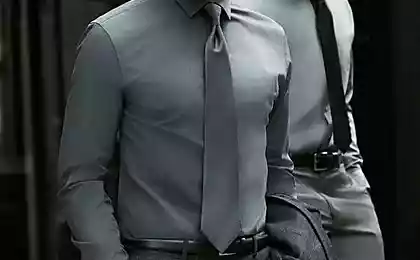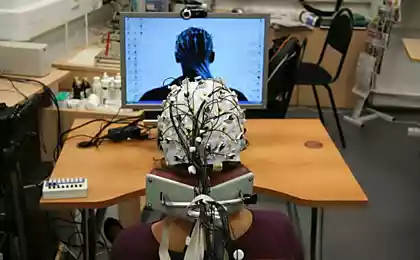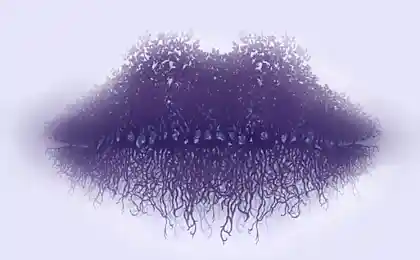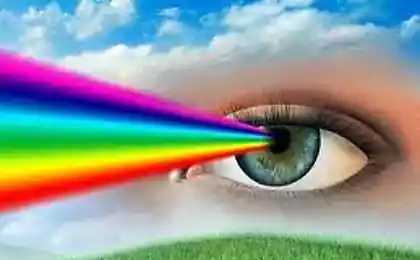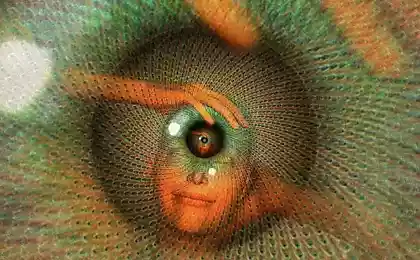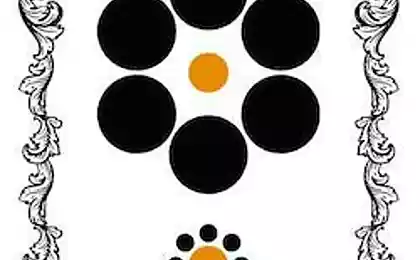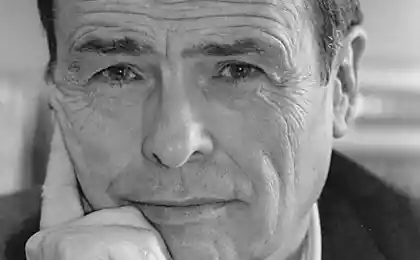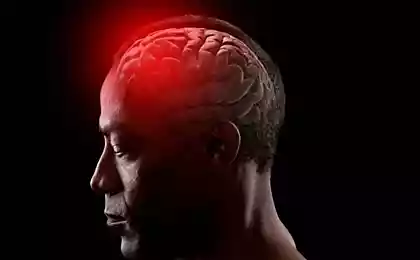623
Shruti Ravindran about synesthesia as a universal method of perception

© JennyVanSommers In the neurology of synesthesia — the phenomenon of perception, in which irritation of one sense causes sensation corresponding to another sense organ. The last thirty years, scientists have actively investigated this phenomenon and came to the conclusion that it is not a rare gift of the few — it is an innate ability each of us. T&P was translated scientific article a journalist Shruti Ravindranath about neurophysiology synesthetic experience, published in the journal Aeon. Vladimir Nabokov once described his famous fictional lolita as a "little Ghost in natural colors". Juicy shades, which he splashed his "little Ghost", was partially the result of a neurological rejection: the letters that occur in the mind of the writer, every time flashed bright colors. In his memoirs Memory, speak" Nabokov described some of them: "b is a hue that painters name is burnt ochre, m — like fold of pink flannel, and I still found now perfect under v — "rose quartz" in the "Dictionary of colors" Mertz and Fields. This ability of literary synesthesia, a neurological oddity, mixing feelings. With her to not only hear music but also see it, or taste shapes that direct your eye. Synesthete, such as Nabokov, you see letters and numbers as if wrapped in a certain color. This kind of synesthesia is called grapheme-color and is the most common and most investigated type, occurring in four out of a hundred. There is also chromesthesia with sounds or notes provoke flashes of color: a symphonic wall of sound can bring to life a real three-dimensional landscape. When spatial sequential synesthesia seconds, days, weeks, months, or years surround the synesthetes like planetary rings. Is lexical-gustatory synesthesia, in which each word or name matches a strong, specific taste: some words are delicious, and some — such bitter that no one can pronounce. Also synesthete reported ordinal-linguistic personification, in which letters and numbers are attributed to gender, color or personality type: 4 can be evil, mean man, forever screaming at his wife, and 6 — a confident, noble woman with exquisite manners. What is synesthesia and why the blue color can smell like raspberries
Neural networks in the brain of the kittens, newborn rhesus monkeys, and people grew thin at the same time with the displacement of some skills in other perception of the world each individual is ineffable, this is the most subjective and self-evident phenomenon, so a synesthete for life are not aware of the strangeness and peculiarity of their own everyday experience. But some still talk about the amazing moment of self-realization in the moment when suddenly I hear from his friends: "I mean my name taste of pea soup?". Such moments of insight are becoming more common since the 1980s, when for the validation of evidence of synaesthetic experiences was first developed cognitive tests. And since the mid 1990-ies of the physiology of different forms of synesthesia began to register by scanning the brain and measuring brain waves. In his article of 2013 in the "Oxford Handbook of synesthesia" Richard Cytowic, a neurologist and researcher of synesthesia in the George Washington University, describes the surprise and delight of synesthetes after experiments finally confirmed the reality of their stories. With the increase in the number of synesthetes who recognize their singularity, become aware of all the new forms of this phenomenon. In 2008, two neurologists from the University of California at San Diego, V. S. Ramachandran and his student David Brang, described the first case of tactile-emotional synesthesia: a young woman instinctively responded to the touch of the textures. Her inspiration came when she told Brango that were crying every time the parents would put on her jeans: they made her disgust and depression. Touching the wax, she was very shy, while silk and introduced her into a state of complete bliss.
The researchers also found that one person can experience different forms of synesthesia. For example, resent from touching the fabric and seeing the letters and numbers painted in different colors. For synesthesia typically recur in families. Parents Nabokov saw letters and numbers in different shades, his mother also saw clouds of colors that accompany the music she listened to. Nabokov's wife Faith and their son Dmitry was the same kind of synesthesia, that of his parents, is grapheme-color synesthesia. As Nabokov said: "...it turned Out that in one case a letter which he [Dmitry] sees purple or perhaps pinkish-purple, is pink for me and blue for my wife. Is the letter M. So the combination of pink and blue lilac color. As if genes were painting in watercolor". ~ But now it turns out that the synesthete may not belong to a private exclusive club. Their rich palette and vivid sensations can be available to all of us. Not being relatives Nabokov, we can also read books watercolor flowers. Some neurologists and psychologists of the age argue about unfinished studies — perhaps, as with Nabokov, we also have a place on the synaesthetic spectrum. You just need to look at the past, at a time when we were babies and our brain just started to develop. For the first time this idea appeared in the form of a thought experiment in "Emile" — the novel of the Enlightenment Jean-Jacques Rousseau. The philosopher suggested that newborn baby the size of an adult, but with children's abilities, to have self-awareness negligible level and mixed sensory perception, something like a vague proteinases. Rousseau wrote: "...the Colors would not reach to his eyes, the sounds would not reach to the ears; the body, which he would refer, would not in his body the sense of touch; he would not know even that he himself is the body. <...> All his feelings were going at one point; his entire existence would be in the General center of the senses (sensorium commune)...".
Inspired by this idea, in 1818, Mary Shelley described the formation of sensual experience of another unusual newborn. "Many sensations flooded into me at once: I began to see, feel, hear and smell, all at the same time. Took a long time before I learned to distinguish between feelings," says the monster in her novel Frankenstein. Psychologist William James described a similar picture of the sensual world of the child in the Principles of psychology". He wrote (and all the rave capital letters belong to him) that "any amount of information from any sensory source, simultaneously within the brain WHICH have NOT YET RECEIVED, will merge into a single undivided object for that mind." As a consequence, "the child, whose attack at the same time the eyes, ears, nose, skin and entrails all at once, feels it all as one great blooming, buzzing, tangle; to the end of life how we distribute all the sensations, related to how all these initially came to us feeling United." If the model of perception of James is true and most of us do share the feelings as they grow older, perhaps synesthete just continue the merge process, which most left behind? Or in other words, if all we were synesthete in infancy?
This unusual idea has resurfaced in 1988 in the book "Peace babies". Its authors — age psychologist Daphne Morer from McMaster University in Ontario and her co-author and husband Charles Morer, had described the sensory world of the newborn, which resembled proteinases of an adult child of Rousseau: "His world smells the same as ours, but he does not perceive odors as coming only through the nose. He hears odors, and sees them, feels them. His world — fight tangy flavor, pungent sounds, and bitter-smelling sounds, redolent of the paintings and touches with a sour smell. If we could visit the world of the newborn, we would have found ourselves inside a hallucinogenic perfumery factory". Morera suggested that all children — synesthete, whose brain is covered multiple connections that convert various stimuli into a perception. Cross-talk signals from different areas of the brain, in their opinion, leads to synesthetic children's perception. This idea first dawned on Charles Morera when he read the book the Soviet psychologist Alexander Luria's "the Mind mnemonist" where Luria remembered "vague synesthetic sensations" of early childhood, where "the mass of fog, and then the colors" meant that roared — might say. Morer asked his wife, while studying the development of vision in infants, is it possible that all newborns — kinestetike. During an interview on Skype Daphne Morer recalls his response: "I said, I don't know... Let me think, how would it manifest, and see the information on the subject." Her sleepy, dreamy voice belonged to a man, all my life trying to get through to kids. "And when I went to look, I realized that this makes sense". "Small book about a large memory", Alexander Luria
She found evidence in studies of the anatomy of the brain 1980-ies and 1990-ies, indicating that the number and length of neural connections weaken as they grow older. With the help of technology anatomical treysing, allows you to designate groups of neurons and to follow the trajectory of their development, research has documented how the neural network in the brain of the kittens, newborn rhesus monkeys, and people grew thin at the same time with the displacement of some other skills. Recent studies that Morer cites as additional evidence to show that people have reduction of neurons is particularly noticeable at the age of seven to nine years. This thinning is gradually led to the disappearance of psychedelic effects at all, except for the synesthetes, whose brain plexus neurons only grew stronger and grew by Analyzing various behavioral experiments Morer found compelling circumstantial evidence supporting the hypothesis of diminishing as they grow up synesthesia and thinner nerve connections. An early example was the study in 1974, scientists at Harvard medical school. "If you connect the electrodes to the head of the newborn and touch the wrist, in the tactile cortex, one can observe the increase in activity, "says Morar," and if at the same time to turn on white noise, change in the tactile cortex become stronger." In other words, in the brain of the newborn, touch and sound reinforce each other. But that's part of the adult brain is not processing sound, shows no increase in activity.
This study strengthens the results of long-term observations on the development of vision in infants, conducted in hospitals. Morer says that when all children in the General wards began to cry loudly, the ones that once gently touched, soft voice said something or covered with a soft duvet, blurred in a blissful smile. Looks like the kids react to the overall level of stimulation, regardless of its origin. It is as if the nervous system just summarized sound, sight and touch.
But over time specificity comes into its own. Morer references Helen Neville, a neuroscientist from the University of Oregon, whose 1995 study showed that it causes the brain waves to auditory and visual brain regions at the six-month babies. This effect decreased in the direction of greater activity in the auditory areas to the age of three years. These and other studies led Morer to the conclusion that hypermania neural network observed in infants, grew thin over time or thinned under the influence of environment and experience. It is believed that this thinning is gradually led to the disappearance of psychedelic effects at all, except for the synesthetes, whose brain plexus neurons only grew stronger and grew. To truly reproduce the experience of an infant impossible, but recently, two psychologists from the University of California San Diego managed to show how effective this phenomenon. Katie Wagner, Karen dobkins was given a two-month, three-month, eight-month-old children and adults black circles and triangles on a blue background, or red-green or blue-yellow. At one point they suggested that the babies synesthete who associated the triangles with red color, will look more at the triangles on a green background, as well as adult subjects. After analyzing the results (for each baby had 100 cycles) Wagner Dobkin confirmed the effect for two - and three-month-old, while eight-month-old children and adults no longer showed consistent associations or preferences. The results of the study were published in the journal Psychological Science in 2011 "synaesthetic associations appear early in life and... disappear with age", which clearly confirms the conjecture of Morrow.
Another study shows that children's synesthesia transformirovalsya in preschool age. The author of this work is Julia Simner, a neuroscientist at the University of Edinburgh, which used periodic surveillance for capturing this process. In a 2009 study published in Brain, she asked 615 six-year-old schoolchildren 13 colors to correlate with the 26 letters of the English alphabet and digits from 0 to 9. Ten seconds later they were tested again with the coincidences. 47 best were tested again a year later. During this time their Association was strong, which gave an idea about the development of synesthesia in real-time. When Simner checked again the future synesthetes three years later, when they were 10-11 years old, she found that consistency of Association is entrenched even more. The trajectory was clear: 34% formed a fixed Association of letters and numbers with colors to seven years, 48 percent to eight, and 71 per cent to 11. Daphne Morer also conducts research in this direction. She was watching three girls with grapheme-color synesthesia with three to four years. These children were asked to match the 96 colors of crayons with letters of the alphabet, numerals, and with four main forms. Tasks were distributed at particular periods for several weeks and repeatedly. At the moment, she found that children without synesthetic tendencies all the time choose different pencils, while children of mothers synesthetes picked the same shades of the same letters, numbers and shapes. A year later, the consistency increases from 40% to 75%. Morer was amazed at how fleshed out were the Association of these children, like those that already possessed by their parents-synesthete. One child, for example, complained that green, any to letter, was not quite the right shade. ~ Lifelong periodic testing was costly and difficult, so today the researchers of synesthesia, the more attention is the so-called cross-modal integration: combining the brain of various sensations such as smells and sounds. You might think that our senses work separately and focus on every image, or sound, like a camera obscura or a laser beam, but in fact, all our senses constantly merge seamlessly to give us a sharper, more vivid picture of the world. Remember alapetite mass, which you ate with a cold, or always known the direction where you want to escape from Sarycheva dogs — it's all your visual impressions, sounds, smells and many other sensations, combining and intertwining in the brain.
These interactions between the senses lead to the emergence of "extravasate", a new sensual tone. For example, you can feel that the source of the high squeak smaller and not as scary as the source of the low roar. The first such cross-sensory correspondence was discovered in 1929 by Edward Sepira, a linguist from the University of Chicago, and Wolfgang Koehler, a psychologist from the University of Berlin. Sapir asked participants in his experiment to correlate two unrelated words, mil and mal, with two tables, one of which was less than the other. All but one participant identified mil as lesser the Desk. Koehler and subjects asked to relate two made-up words, takete and maluma, with two forms: one is lumpy and rounded, and the second with sharp teeth. Most were confident that takete — pointed shape and maluma — rounded. Subsequent studies have shown that children and adults tend to associate brightness with loudness, and a small ball with a high sound. Going back to our childlike mind, at the time of the flowering of our synesthetic abilities, we can enhance fills us impressions from the outside world, Researchers are interested in the possibility of the existence of such interactions on a single continuous spectrum is weak among nusiniscato, strong among the synesthetes. Maybe we all have access to enriched perception, which is observed in synesthetes. Daphne Morer, which considers these relationships as connections between brain regions that survived the process of thinning of the neural networks, thinks so. As neuroscientist Edward Hubbard from the University of Wisconsin in Madison. "Your actual perception of the world is highly integrated and constantly combines all kinds of information from different sensory modalities, synesthetes this process more intense," he says.
A famous example is the effect of MC Gurk is a psychedelic illusion, discovered by the British psychologist Harry Mack-Gurkom in 1976. In his experiment, an audio recording of a repeated phoneme "BA" plays along with the video of a person saying "GA." The sound in the end is mixed in the brain in a cross and resembles something like, "Yes." The versatility of this cross-sensory quality might make all of us partly synesthete. "It shows that speech perception is actually a multisensory phenomenon in which different senses convey to us information," says Hubbard. In 2001, a number of experiments Hubbard and his then adviser Ramachandran revealed a probable intersection of these compounds. It is the angular gyrus, a tiny region connected with the main areas of the brain processing touch, hearing and sight. Hubbard and Ramachandran showed three patients with damaged angular gyrus abstract forms, which they named "Buba" and "Kiki," this was their version of the problem maluma/takete. "Patients were much more complex than healthy College students, determine that a spherical form is 'Bouba' and the spiky — 'Kiki'," said Hubbard. Hubbard and Ramachandran asked the patient to explain metaphors or turns of phrase, such as "he left the post of Director (he stepped down as director). It is not surprising that patients usually do not cope with the linguistic challenges. Damage to the angular gyrus has destroyed the ability to sense additional language values, namely to recognize that the "angular" can refer to something visible, such as a pointed shape, and sound, such as a ragged guitar riff or the word "Kiki". They lacked the additional language of intuition which most of us take for granted. Indeed, the researchers came to the conclusion that the versatility of this cross-sensory quality and the fact that it can be incorporated in our anatomy, might make us all hidden synesthete.

"If we can mathematically describe music, we will understand how our brain works": Marina Korsakova-kreyn about the perception of music it is Possible that synesthesia is behind metaphors and art. Just ask Megan HART. "The word "love" tastes like the smell of fresh ink and soft paper. As just written a poem," she wrote in the novel "Tear You Apart". Poetry, like prose, is inherently cinestation and synesthet is their secret source.
The idea of universal synesthesia has caused a stir in November last year at a meeting of the Society for neuroscience in Washington, where the researchers stated that synesthetic abilities could explain why people with sensory deficit unable to function normally. Jenessa Seymour, doctoral candidate at the University of Illinois at Urbana-Champaign, described an experiment to prove that people born deaf have acute peripheral vision especially useful in low light conditions. Additional resource required for this supertree, she says, is concentrated in the rear part of the upper temporal gyrus, which in a healthy person is used to merge sound and sight. Ryan Stevenson, a neuroscientist from the University of Toronto, worked on the study of this region of the brain involved in speech perception, reading facial expressions, interpreting emotions and understanding the intentions of others. All of these functions, he noted, patients with autism were impaired. In the experiment, he tested the ability of normal children and children with autism to combine auditory and visual information. First, it measured how well children were able to perceive simple non-speech sounds, such as beeps and whistles. Then the children were asked to combine sound and image in the test for the effect of MC Gurk. They showed a video of a person saying "GA" along with audio, a spoken "BA". The researchers found that both groups equally well perceived the beeps and whistles, but children with autism are much less likely to have reported that you hear a combined sound of "Yes." Many reported hearing "BA".
Stevenson came to the conclusion that children with autism are slower combined what I saw with what I heard, especially in speech. "Children with autism are harder to piece together what they hear and see. The effect is similar to what you can better hear the person in the noisy room, if you see him mouth," explained Stevenson.
Taken together, these findings show that we are all latent synesthete to a greater or lesser extent. The farther we are on the autistic spectrum, the less we cinestation. Synesthesia contributes not only to unions in their own mind but between minds. Carousel of feelings guides our early development and drives our humanity. Mentally returning to our childlike mind, at the time of the flowering of our synesthetic abilities, we can enhance fills us impressions from the outside world. published by P. S. And remember, just changing your mind — together we change the world! ©
Source: theoryandpractice.ru
